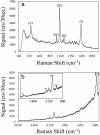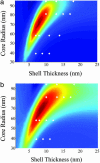Surface-enhanced Raman scattering on tunable plasmonic nanoparticle substrates
- PMID: 15608058
- PMCID: PMC539806
- DOI: 10.1073/pnas.0408319102
Surface-enhanced Raman scattering on tunable plasmonic nanoparticle substrates
Abstract
Au and Ag nanoshells are investigated as substrates for surface-enhanced Raman scattering (SERS). We find that SERS enhancements on nanoshell films are dramatically different from those observed on colloidal aggregates, specifically that the Raman enhancement follows the plasmon resonance of the individual nanoparticles. Comparative finite difference time domain calculations of fields at the surface of smooth and roughened nanoshells reveal that surface roughness contributes only slightly to the total enhancement. SERS enhancements as large as 2.5 x 10(10) on Ag nanoshell films for the nonresonant molecule p-mercaptoaniline are measured.
Figures







References
-
- Jeanmarie, D. L. & Van Duyne, R. P. (1977) J. Electroanal. Chem. 84, 1.
-
- Moskovits, M. (1985) Rev. Mod. Phys. 57, 783–826.
-
- Fleischmann, M., Hendra, P. & McMillan, A. (1974) Chem. Phys. Lett. 26, 163–166.
-
- Fleischmann, M., Hendra, P. J. & McQuillan, A. J. (1973) J. Chem. Soc. Chem. Commun. 3, 80–81.
-
- Maher, R. C., Cohen, L. F., Etchegoin, P., Hartigan, H. J. N., Brown, R. J. C. & Milton, M. J. T. (2004) J. Chem. Phys. 120, 11746–11753. - PubMed
Publication types
MeSH terms
Substances
LinkOut - more resources
Full Text Sources
Other Literature Sources
Miscellaneous

